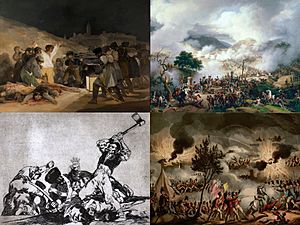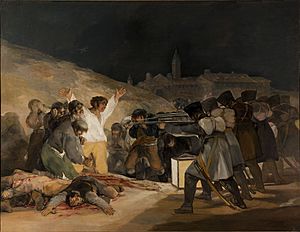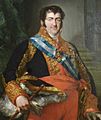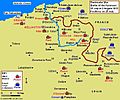Peninsular War facts for kids
The Peninsular War (1807–1814) was a big conflict. It was fought between the French Empire and the countries of Spain and Portugal. The war was about who would control the Iberian Peninsula, which is where Spain and Portugal are located.
The war started in 1807 when French and Spanish armies invaded Portugal. It became much bigger in 1808. That's when France attacked Spain, which was Portugal's ally. France then made Joseph Bonaparte, Napoleon's brother, the new king of Spain. A famous general, Sir Arthur Wellesley, became well-known during this war. The fighting lasted until 1814. That's when several European countries, called the Sixth Coalition, finally defeated Napoleon.
Contents
Why the War Started: Portugal
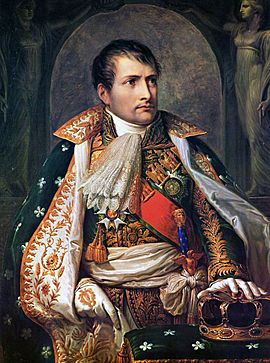
In July 1807, Napoleon and Emperor Alexander I of Russia made peace treaties. Napoleon was annoyed that Portugal was still trading with Britain. He ordered Portugal to stop trading with Britain and declare war on them. When Portugal refused, Napoleon sent his troops to march towards Lisbon, Portugal's capital.
France and Spain secretly signed a deal called the Treaty of Fontainebleau. They planned to divide Portugal into three parts. Napoleon's army was supposed to get help from 25,500 Spanish soldiers. On October 12, French troops led by General Junot entered Spain. Junot was chosen because he had been an ambassador to Portugal before. He was known as a good soldier.
France Invades Portugal
Napoleon told Junot to invade Portugal with Spanish help. Junot's troops marched from Spain into Portugal. On November 19, 1807, the French army headed for Lisbon. They took control of the city on November 30.
The Portuguese Prince Regent, John, escaped just in time. He loaded his family, important papers, and treasures onto ships. The British navy protected his fleet. They sailed away to Brazil, which was a Portuguese colony. Many nobles and merchants also fled with him. They left so quickly that 14 carts full of treasure were left behind.
One of Junot's first actions was to take the property of those who had fled. He also demanded a huge payment of 100 million francs from Portugal. The Portuguese army was forced to join the French. They were sent to Germany. Junot tried to keep his soldiers under control. But the Portuguese people were very angry. The high taxes made them even more upset. By January 1808, some people who resisted the French were executed. The situation was tense, and a spark was needed to start a full revolt.
Changes in Spain's Government
Between February 9 and 12, French armies entered Spain. They took over important cities and forts in Navarre and Catalonia. The Spanish government asked France for an explanation. But they were not happy with the answers. So, Spain pulled its troops out of Portugal. Spanish fort commanders were confused. They didn't know how to treat the French soldiers. The French marched in openly, with flags and music, acting like allies. Some commanders let them in, others tried to stop them.
On February 20, Joachim Murat, Napoleon's brother-in-law, became the commander of all French troops in Spain. There were now between 60,000 and 100,000 French soldiers. In early March, Murat received 6,000 more soldiers.
On March 19, 1808, a rebellion called the Mutiny of Aranjuez happened. The king of Spain, Charles IV, was forced to give up his throne. His son, Ferdinand VII, became the new king. After this, people often attacked those who supported the old king's chief minister. On March 23, Murat entered Madrid in a grand procession. Ferdinand VII arrived on March 27. He asked Murat to get Napoleon to approve his new kingship.
However, Charles IV complained to Napoleon about being forced to abdicate. Napoleon called the entire Spanish royal family to Bayonne, France. There, on May 5, under French pressure, both kings gave up their claims to the throne. Napoleon then had the Spanish council in Madrid ask him to make his brother, Joseph, the King of Spain. The news of Ferdinand's abdication was not made public until May 20.
Spain and Portugal Fight Back
On May 2, the people of Madrid rebelled against the French army. This uprising is known as the Dos de Mayo Uprising. Murat's elite soldiers quickly put down the rebellion. They rode into the city and crushed the rioters. French soldiers, including some from Egypt who wore turbans and used curved swords, fought the people of Madrid. This reminded the Spanish of past Muslim rule.
The next day, the French army shot hundreds of Madrid's citizens. This event was famously painted by Francisco Goya in The Third of May 1808. Similar harsh actions happened in other cities for days. Bloody, unplanned fighting, known as guerrilla (meaning "little war"), broke out across Spain. People fought against the French and the old Spanish government.
Even though the Spanish government accepted Napoleon's brother, Joseph, as king, the Spanish people did not. The first uprisings happened in Cartagena and Valencia on May 23. Zaragoza and Murcia followed on May 24. The province of Asturias kicked out its French governor on May 25 and declared war on Napoleon. Within weeks, all Spanish provinces joined the fight. After hearing about the Spanish uprising, Portugal also revolted in June. A French group crushed rebels at Évora on July 29 and killed many people in the town.
The worsening situation made France send more soldiers. By June 1, over 65,000 troops rushed into Spain to control the crisis. The main French army of 80,000 held a small area in central Spain. Another 30,000 French troops were in Madrid. Junot's army in Portugal was cut off by hundreds of miles of enemy land. But within days of the revolt, French soldiers were searching for rebel forces.
In 1808, the Spanish Army in Andalusia defeated the French at the Battle of Bailen. This was the first time Napoleon's army was defeated in an open battle in Europe. Later, a new Spanish government, called the Cortes of Cádiz, was formed. It was like a government-in-exile. They fortified themselves in the safe port of Cádiz in 1810. They were surrounded by 70,000 French troops.
Britain Joins the Fight
In August 1808, 15,000 British soldiers arrived in Portugal. They were led by Sir Arthur Wellesley. The British protected Portugal and fought against the French. They worked with the newly organized Portuguese army. They also sent supplies to the Spanish. The Spanish armies and guerrillas kept many of Napoleon's troops busy.
The War Ends
In 1812, Napoleon led a huge army to invade Russia. This invasion was a disaster for him. While he was busy in Russia, the combined armies of Britain, Spain, and Portugal defeated the French at the Battle of Salamanca. They then captured the capital city of Madrid. The next year, the allied forces won another big victory against King Joseph Bonaparte's army at the Battle of Vitoria. This paved the way for the end of the war in the Iberian Peninsula.
Marshal Jean-de-Dieu Soult led the tired French forces back across the Pyrenees mountains. They were no longer getting enough support from France. The years of fighting in Spain had been a huge burden on Napoleon's army. Even though the French won some battles, they were eventually defeated. Their supplies were cut off, and their units were often alone. Spanish fighters, called partisans, constantly attacked them in a fierce guerrilla war. The Spanish armies were often beaten, but they would always regroup. They kept harassing and tiring out the French troops. This drain on French resources made Napoleon call the conflict the "Spanish Ulcer."
The war and revolution against Napoleon's rule led to the Spanish Constitution of 1812. This constitution was a very important document for freedom in Europe. The war also badly damaged Portugal and Spain. It caused civil wars between groups who wanted freedom and those who wanted the old system. This led to revolts in Latin America and a time of trouble and slow economic growth.
On April 13, 1814, Napoleon gave up his power. The Peace of Paris was officially signed on May 30, 1814.
What Happened Next
Ferdinand VII remained King of Spain. Napoleon had recognized him as king on December 11, 1813. People who had supported the French were sent away to France. The whole country of Spain had been badly damaged by Napoleon's troops. The Catholic Church also suffered great losses. Society faced many changes.
After Napoleon was sent away to the island of Elba, Louis XVIII became the king of France again.
Some British troops were sent back to England. Others sailed to America to fight in the final months of the American War of 1812.
After the Peninsular War, there were more conflicts in Spain. Groups who wanted independence and those who wanted a more liberal government fought. King Ferdinand VII took back all the changes made by the Spanish government in Cádiz. He cancelled the Constitution of 1812 on May 4, 1814. But military officers forced Ferdinand to accept the constitution again in 1820. This period lasted until April 1823.
The experience of self-rule in Spain inspired leaders in Spanish America. They began to push for their own independence.
Portugal was in a better situation than Spain. There was no revolt in Brazil, and no colonial struggle. The Portuguese royal family's move to Rio de Janeiro helped start the independence of Brazil in 1822.
The war against Napoleon was one of the bloodiest events in Spain's modern history.
Images for kids
-
The Portuguese royal family escaping to Brazil.
-
Joaquín Sorolla: The death of Pedro Velarde y Santillán during the defence of the Monteleon Artillery Barracks.
-
Joaquín Sorolla: Valencians prepare to resist the invaders (1884).
-
The Spanish Army's triumph at Bailén was the French Empire's first land defeat. Painting by José Casado del Alisal.
-
La bataille de Somosierra by Louis-François, Baron Lejeune (1775–1848). Oil on canvas, 1810.
-
Marshal Jean-de-Dieu Soult at the First Battle of Porto by Joseph Beaume.
-
The Proclamation of the Constitution of 1812 by Salvador Viniegra.
-
Silver coin: 1000 reis Manuel II of Portugal, 1910 - commemorating the Peninsular War.
-
The Battle of Chiclana, 5th March 1811 (1824) captures the fight between British redcoats and the French troops for Barrosa Ridge.
-
British infantry attempt to scale the walls of Badajoz, 1812.
-
The Battle of Salamanca.
-
Thomas Lawrence: Arthur Wellesley, 1st Duke of Wellington.
-
Battle of the Pyrenees, 25 July 1813.
-
The Battle of the Bidassoa, 1813.
-
The Battle of Castalla.
-
French victories of the Peninsular War inscribed on the Arc de Triomphe.
-
Statue of Juana Galán in Valdepeñas, by sculptor Francisco Javier Galán.
See also
 In Spanish: Guerra de la Independencia Española para niños
In Spanish: Guerra de la Independencia Española para niños


